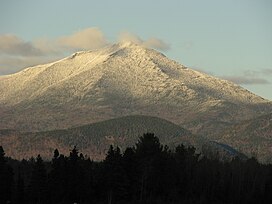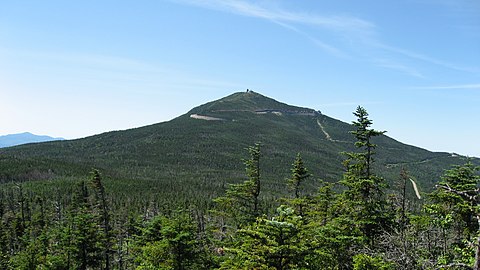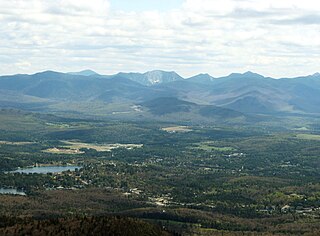
Lake Placid is a village in the Adirondack Mountains in Essex County, New York, United States. In 2020, its population was 2,205.

The Adirondack Park is a park in northeastern New York protecting the Adirondack Mountains. The park was established in 1892 for "the free use of all the people for their health and pleasure", and for watershed protection. At 6.1 million acres, it is the largest park in the contiguous United States.

Mount Marcy is the highest point in the U.S. state of New York, with an elevation of 5,343.1 feet (1,628.6 m). It is located in the town of Keene in Essex County. The mountain is in the heart of the High Peaks Wilderness Area in Adirondack Park. Like the surrounding Adirondack Mountains, Marcy was heavily affected by large glaciers during recent ice ages, which deposited boulders on the mountain slopes and carved valleys and depressions on the mountain. One such depression is today filled by Lake Tear of the Clouds, which is often cited as the highest source of the Hudson River. The majority of the mountain is covered by hardwood and spruce-fir forests, although the highest few hundred feet are above the tree line. The peak is dominated by rocky outcrops, lichens, and alpine plants. The mountain supports a diverse number of woodland mammals and birds.
The Adirondack High Peaks are a set of 46 mountain peaks in the Adirondack Mountains of New York state. They have been popular hiking destinations since the late 1920s, when the list of peaks was published in Russell Carson's book Peaks and Peoples of the Adirondacks. Those who have climbed all 46 High Peaks are eligible to join the Adirondack Forty-Sixers club.

Cascade Mountain is in Essex County of New York. It is one of the 46 Adirondack High Peaks (36th) and is located in the Adirondack Park. Its name comes from a series of waterfalls on a brook near the mountain's base. The lake it flows into and the pass between Cascade and Pitchoff mountains are also named Cascade.

Algonquin Peak is a mountain in the MacIntyre Range of the Adirondacks in the U.S. state of New York. It is the second highest mountain in New York, with an elevation of 5,114 feet (1,559 m), and one of the 46 High Peaks in Adirondack Park. It is located in the town of North Elba in Essex County. The first recorded ascent of the mountain was made on August 8, 1837, by a party led by New York state geologist Ebenezer Emmons. It was originally named Mount McIntyre, after Archibald McIntyre, but this name was eventually applied to the entire range. Surveyor Verplanck Colvin added the name "Algonquin" in 1880. This name came from the peak reputedly being on the Algonquian side of a nearby informal boundary between the Algonquian and their Iroquois neighbors, although no such boundary existed in reality.

Mount Haystack is a mountain in the Great Range of the Adirondack Mountains of New York. With an elevation of 4,960 feet (1,510 m), it is the third highest mountain in New York and one of the 46 High Peaks in Adirondack Park. It is located in the town of Keene in Essex County. The first recorded ascent of the mountain was made by mountain guide Orson Schofield Phelps in 1849, accompanied by Almeron Oliver and George Etsy. Phelps gave the mountain its current name based on its appearance to a haystack, and later cut the first trail to the summit in 1873. The summit is an alpine zone above the treeline, which offers a view of nearby Mount Marcy and Panther Gorge.

Mount Skylight is a mountain in the Adirondacks in the U.S. state of New York. Skylight is the fourth highest peak in New York, with an elevation of 4,924 feet (1,501 m), and one of the 46 High Peaks in Adirondack Park. It is located in the town of Keene in Essex County. The mountain was given its name by artist Frederick S. Perkins and guide Orson Schofield Phelps in 1857, due to a rock formation on the peak resembling a window. Phelps would later make the first known ascent of the peak with surveyor Verplanck Colvin and two others on August 28, 1873.
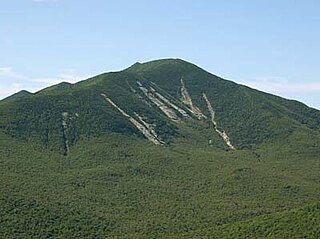
Dix Mountain is a mountain in the Dix Range of the Adirondacks in the U.S. state of New York. With an elevation of 4,857 feet (1,480 m), it is the sixth highest peak in New York and one of the 46 High Peaks of the Adirondack Park. It is located roughly on the boundary between the towns of North Hudson and Keene in Essex County. The crest of the peak consists of a very narrow ridge, which continues to the southeast and rises to a subsidiary peak named Beckhorn, then continues south to other peaks of the Dix Range. The summit is also in an alpine zone above the treeline. The ridge offers unobstructed views of Elk Lake to the southwest, the Great Range to the northwest, and Lake Champlain and the Green Mountains to the east.
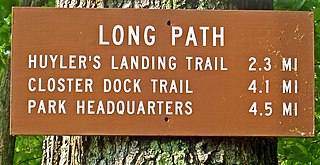
The Long Path is a 357-mile (575 km) long-distance hiking trail beginning in New York City, at the West 175th Street subway station near the George Washington Bridge and ending at Altamont, New York, in the Albany area. While not yet a continuous trail, relying on road walks in some areas, it nevertheless takes in many of the popular hiking attractions west of the Hudson River, such as the New Jersey Palisades, Harriman State Park, the Shawangunk Ridge and the Catskill Mountains. It offers hikers a diversity of environments to pass through, from suburbia and sea-level salt marshes along the Hudson to wilderness and boreal forest on Catskill summits 4,000 feet (1,220 m) in elevation.

Mount Colden is a mountain in the Adirondacks in the U.S. state of New York. It is the eleventh-highest peak in New York, with an elevation of 4,714 feet (1,437 m), and one of the 46 High Peaks in Adirondack Park. It is located in the town of Keene in Essex County. The peak is named after David C. Colden, an investor in the McIntyre Iron Works at Tahawus. The mountain is known for the Trap Dike on its west face, which forms a large crevice running up the mountain that can be clearly seen from Avalanche Lake. The summit of the mountain can be reached by two hiking trails, which are frequently combined to form a circuit through Avalanche Pass, or by climbing the Trap Dike. The summit is in an alpine tundra zone above the treeline, and offers views of surrounding mountains and lakes.

Mount Jo is a 2,832-foot-tall (863 m) mountain in the heart of the Adirondack Mountains of New York. It is in North Elba, New York on land owned by the Adirondack Mountain Club. The Adirondack Loj and Heart Lake are at the foot of Mount Jo. There are two trails that lead to its summit.

Giant Mountain, also known as Giant of the Valley, is a mountain in the Adirondacks in the U.S. state of New York. It is the twelfth-highest peak in New York, with an elevation of 4,627 feet (1,410 m), and one of the 46 High Peaks in Adirondack Park. It is located in the Giant Mountain Wilderness Area, in the town of Keene in Essex County. The mountain is named for its towering appearance from the nearby Pleasant Valley to the east, which sits at a low elevation.

Gothics is a mountain in the Great Range of the Adirondacks in the U.S. state of New York. It is the tenth-highest peak in New York, with an elevation of 4,736 feet (1,444 m), and one of the 46 High Peaks in Adirondack Park. It is located in the town of Keene in Essex County. The mountain is named due to the resemblance of its three arched peaks and large rock slides to Gothic architecture. Although the name has been attributed to Orson Schofield Phelps and Frederick W. Perkins, who named several peaks during an 1857 ascent of Mount Marcy, other evidence shows the name Gothics in use at least as early as 1850. The earliest recorded ascent was made on October 11, 1875, by Verplanck Colvin, Roderick L. McKenzie, and Ed Phelps, although an unrecorded ascent was likely made earlier by James J. Storrow and Orlando Beede. The summit of Gothics is an alpine tundra zone, and on clear days views of 30 nearby peaks are available, as well as the Upper and Lower Ausable Lakes.
The High Peaks Wilderness Area is the largest wilderness area of the Forest Preserve in the U.S. state of New York. It is located in three counties and six towns in the Adirondack Park: Harrietstown in Franklin County, North Elba, Keene, North Hudson and Newcomb in Essex County and Long Lake in Hamilton County.

Esther Mountain is a mountain located in Essex County, New York. The mountain is the northernmost of the High Peaks of the Adirondack Mountains and its 28th highest peak. It was the only High Peak named for a woman until 2014, having been named in honor of Esther McComb, who made the first recorded climb to the summit in 1839, at age 15; at the time she was attempting to climb Whiteface Mountain from the north.
Black Mountain is a mountain located in Washington County, New York, of which its peak is the highest point. Isolated from the rest of the Adirondack Mountains by Lake George, Black Mtn. has the seventh highest topographic prominence of all the mountains in New York. Black Mountain also has the highest elevation of any of the peaks which surround Lake George and offers unobstructed views of the lake from its summit.

New York State Route 431 (NY 431) is a state highway in Essex County, New York, in the United States. The highway, also known as the Whiteface Mountain Veterans Memorial Highway, begins at an intersection with NY 86 in Wilmington and climbs Whiteface Mountain in the Adirondacks. The New York State Department of Environmental Conservation maintains the highway, which is 7.96 miles (12.81 km) long.
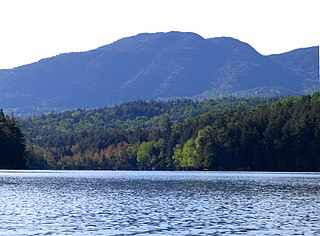
Ampersand Mountain is a 3,352 ft (1,021.7 m) mountain in Franklin County in the High Peaks Wilderness Area of the northeastern Adirondacks, west of the High Peaks proper in New York State. The trail up the mountain begins on New York State Route 3 8.1 miles (13.0 km) southwest of the village of Saranac Lake, near Middle Saranac Lake; it is a popular day hike. The mountain takes its name from nearby Ampersand Creek, so named because it twists and turns like the ampersand symbol. The summit is bare rock, with extensive views of the High Peaks to the east and the Saranac Lakes to the west. Stony Creek Mountain is located west-southwest of Ampersand Mountain. The mountain is notable as the land surrounding its hiking trail's initial ascent is generally acknowledged as unlogged old growth forest.
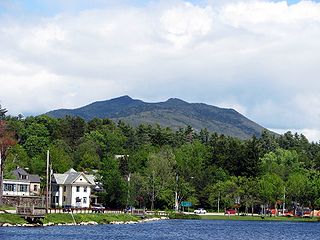
McKenzie Mountain is a 3,861-foot (1,177 m) mountain in western Essex County in the towns of St. Armand and North Elba in the Adirondack Park, a unit of the Forest Preserve.
